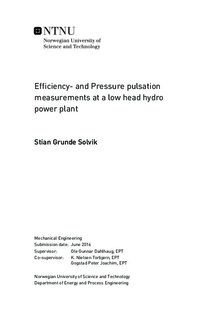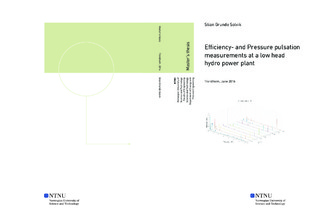| dc.description.abstract | Stian Solvik and Peter Joachim Gogstad completed efficiency Measurement for turbine 2 at Leirfossene power plant on 26 May 2016. The measurements were carried out as part of an ongoing research collaboration between NTNU and Statkraft. The thermodynamic method is used to measure the turbine efficiency. The measurements have been carried out in accordance with the International Standard IEC 60041, 3.ed 19991-11 [1]. One temperature sensor was installed at the inlet to the turbine and three temperature sensors with manifolds were installed in the outlet. Atmospheric pressure and pressure at the inlet of the turbine was measured with suitable pressure sensors, while pressure at the outlet has been numerically calculated. The relative efficiencies, net head and water flow at the nominal head of 58m is given in Table 17 and Table 18. The maximum uncertainty in efficiency is calculated to be 1.4%.
Pressure measurements has been performed in the draft tube on turbine 2. Eight pressure sensors have been used. Respectively four sensors are placed in the same vertical axis, on each side of the draft tube by a vertical distance of 860mm downstream of each other. The measurements were performed under steady state conditions, with a constant generator power and discharge. All operating point are related to the nominal discharge〖 Q〗_n.
The pressure pulsation measurements show that the Rheingans frequency, runner frequency and runner vane frequency are present in the draft tube. The Rheingans frequency is the dominant frequency while operating at part load. The runner frequency displays a high intensity at both part- and high- load The runner vane frequency shows a high intensity at the outlet of the turbine.
The analysis of the pressure intensity shows the highest pressure pulsations measured for BEP, part load and high load are respectively 45kPa,250kPa,55kPa.
The sensors located closest to the inner radius of the draft tube bend experience a lower intensity than the sensors at the outer radius of the bend. This is probably a flow-specific phenomenon that occurs in the draft tube bend. Air injection into the draft tube is installed to reduce the intensity of pressure pulsations that occur during part load. Data with and without air injection from two operating point at 0.46*Qn and 0.58*Qn, have been compared. The analysis shows that the air injection reduces the overall intensity by 22% at 0.46*Qn and 10% at 0.58*Qn. The most powerful pulsations are reduced by 20% to 60%, while the remaining pulsations experienced a change from -14% to 17%. Frequency analysis at part load 0.46*Qn, show two distinct frequencies at 4.64Hz and 5.06Hz when the turbine runs without air injection. When air is injected into the draft tube, these frequencies disappear altogether. The frequencies are probably related to elastic fluctuations in the system, which are damped by the injected air. | |

